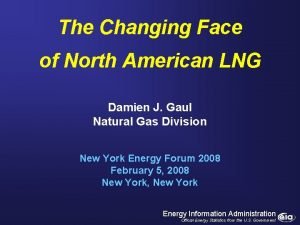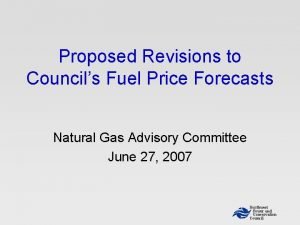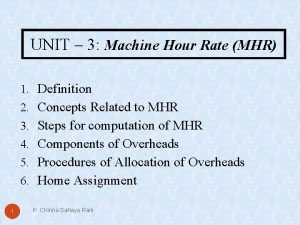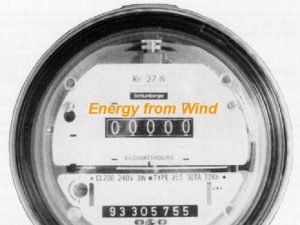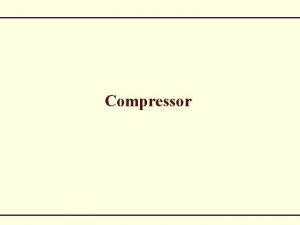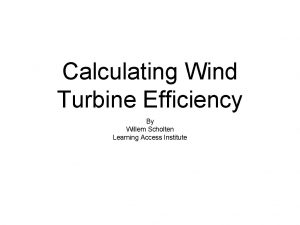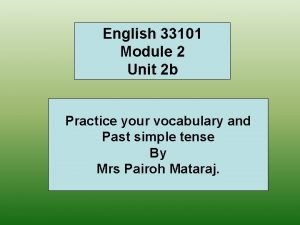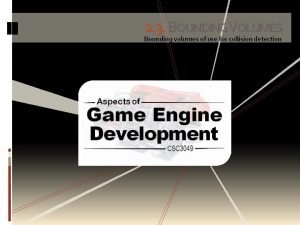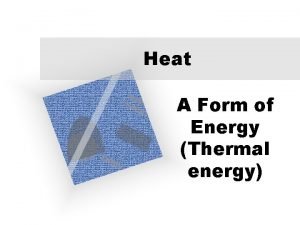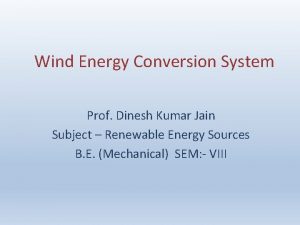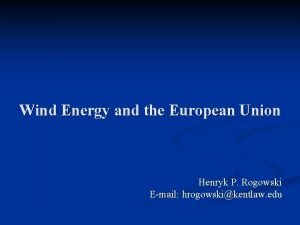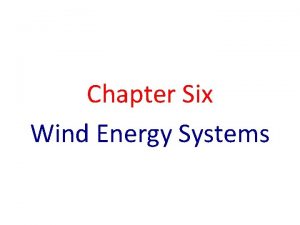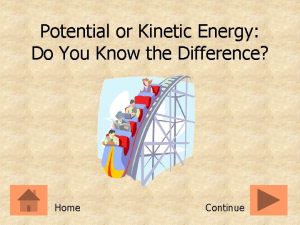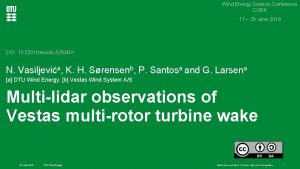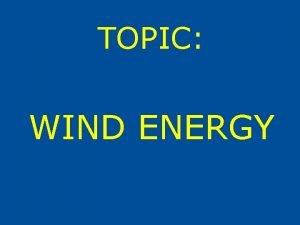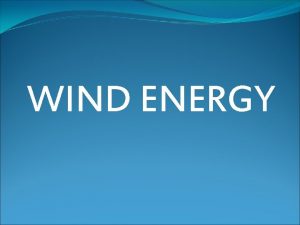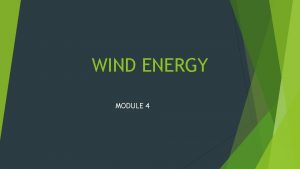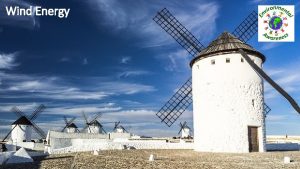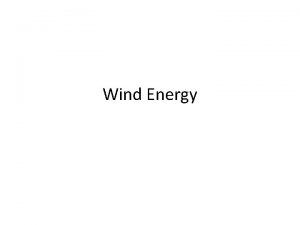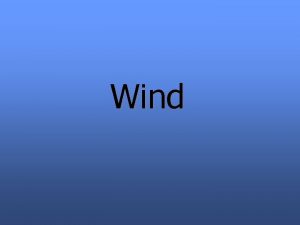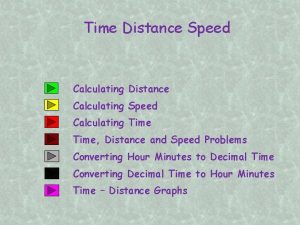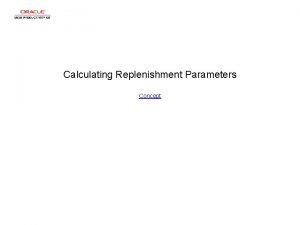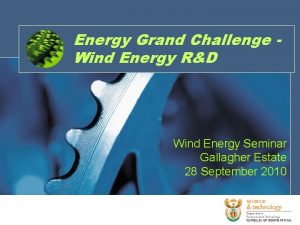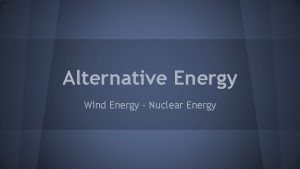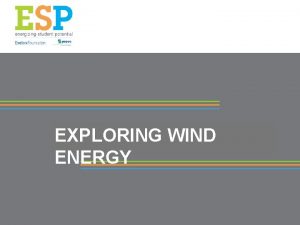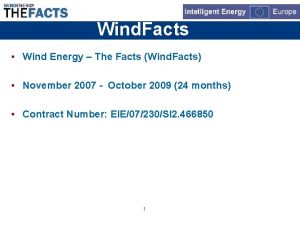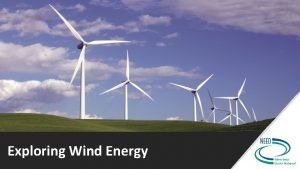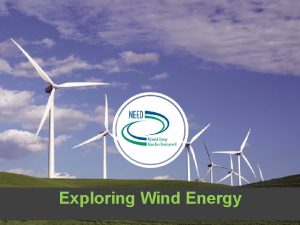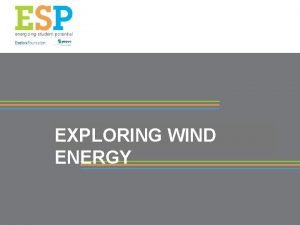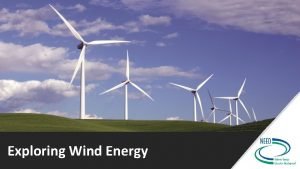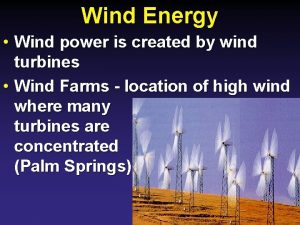Energy from Wind Methods of Calculating AEO Swept






























- Slides: 30

Energy from Wind

Methods of Calculating AEO • Swept Area Method • Manufacturers Estimates • Power Curve Method

Swept Area Method

Wind Speed Distributions Credit: Paul Gipe

Wind Speed Distributions • Wind is empirically known to follow a Weibull probability distribution • Weibull curve: has shape parameter k • Average k in US: k = 2 (Raleigh distribution)

Specifications v Rotor Diameter: 8. 2 ft (2. 5 m) v Rotor Area: 53 ft 2 (4. 9 m 2) v Rated Power: 1, 000 W v Peak Power: ~1, 800 W v Rated Wind Speed: 24. 6 mph (11 m/s) v Rated Rotor Speed: 490 RPM v Start-up Wind Speed: 6. 7 mph (3 m/s) v Cut-in Wind Speed: 5. 6 mph (2. 5 m/s) v Furling Wind Speed: 29 mph (13 m/s) v Cut-out Wind Speed: None v Max. Design Wind Speed: 120 mph (54 m/s) v Net Weight: 75 lbs (34 kgs) v Shipping Weight: 95 lbs (43 kgs) Power Curve

Specifications v Rotor Diameter: 20. 2 ft (6. 2 m) v Rotor Area: 320 ft 2 (30. 2 m 2) v Rated Power: 10 k. W (Grid), 7. 5 k. W (Battery) v Peak Power: ~11 W (Grid), ~ 8. 5 k. W(Battery) v Rated Wind Speed: 31 mph (14 m/s) v Rated Rotor Speed: 300 RPM v Start-up Wind Speed: 7. 5 mph (3. 4 m/s) v Cut-in Wind Speed: 7. 5 mph (3. 4 m/s) v Furling Wind Speed: 36 mph (16 m/s) v Cut-out Wind Speed: None v Max. Design Wind Speed: 120 mph (54 m/s) v Net Weight: 1, 020 lbs (464 kgs) v Shipping Weight: 1, 250 lbs (568 kgs) Power Curve

Turbine Ratings are weird • Bergey XL. 1 • Rated Power 1 k. W • Does it produce 1000 W all of the time? • NO! Only a small percentage of time….

Turbine Ratings are weird • ARE 110 • Swept Area 10. 1 m² (110 sq. ft. ) • Rated Power 2. 5 k. W

Turbine Ratings are weird • Whisper 500 • About 500 k. Wh/month at a site with a 12 mph annual average wind speed • Rated Power 3. 0 k. W

Turbine Ratings are weird • AWP 3. 6 • Rotor Diameter – 11. 8 ft. (3. 6 m) • Rated Power – 850 W(24 V) – 1000 W (48 V) – 1600 W (Grid Connect)

Turbine Ratings are weird • Vestas V 90 -3. 0 MW • Rotor Diameter – 90 m (295 ft) • Rated Power – 3, 000 W – or 3, 000 k. W – or 3 MW

Power Curve • Southwest Windpower Whisper 100 and Whisper 200 • Similar rated power • Difference in energy

Power • Power: Rate at which energy is delivered Power = Energy Time • Measured in Watts (W), kilowatts (k. W), or horsepower • Power is an instantaneous quantity • Power does not accumulate • Think gallons per minute

Energy • Energy: Ability to do something • Measured in kilowatt Hours (k. Whrs) • Why? – Since Power = Energy/Time, then Power Time = Energy • Energy does accumulates over time • Think gallons • Gallons = (gallons/min) minutes

Wind Resource • At any instant, the only question that makes sense is “What’s the power of the wind? ” • Answer depends on 2 quantities – Instantaneous wind speed, v – Air density, , which depends on • • Elevation Temperature Weather At sea level and 77 F (standard conditions), air density = 1. 225 kg/m 3 • At 5, 000 ft elevation, is ~16% less than at sea level

Power Density of the Wind • Power Density: P/A = ½ v 3 (in W/m 2) • Example: Suppose the wind speed is 8. 0 m/s, and air density is 1. 0 kg/m 3, then P/A = ½ (1. 0 kg/m 3)(8. 0 m/s)3 = 256 W/m 2 – For each square meter of area, there are 256 W of power – Use Metric Units! – If wind speed doubles, power density increases by 8

Swept Area • The single most important parameter of a wind turbine is its rotor’s swept area A

Power of a Wind Turbine • The power of a wind turbine is P = ½ v 3 A CP A: swept area of rotor CP: rotor efficiency • Example: A 2. 5 m diameter turbine with a 25% efficient rotor in our 8. 0 m/s wind will have P = ½ (1. 0 kg/m 3)(8. 0 m/s)3 [ (2. 5 m/2)2](0. 25) = 314 W

Energy in the wind • How much energy can this turbine produce? • Need a constant wind speed and time • Example: If the wind speed is a constant 8. 0 m/s, then in 1 month our turbine will produce – (314 W)(30 days)(24 hrs/day) = 226 k. Whrs – The average home in NC uses around 850 k. Whrs/month

Method of Bins • There are limitations to this method… – Wind speed is not constant! – Rotor efficiency depends on wind speed! • Small turbines furl in high winds • Here’s a better method: Method of Bins – Need to know (or approximate) your wind distribution – Power Curve of turbine

Wind Distribution • Wind is known to follow a Weibull distribution • =WEIBULL(v, k, vavg, 0) • Rayleigh Distribution if k=2 Credit: Paul Gipe

Power Curve • The turbine’s manufacturer will provide you with its power curve Bergey XL. 1

Method of Bins • Calculate Energy = Power Time for each wind speed bin • Sum ‘um up!

Method of Bins Power Curve Wind Distribution (data) Annual Energy Output

How? • How do you get a power curve? – From the manufacturer – Measure power and wind speed and make bins; follow IEC standards • How do you get a wind distribution? – Measure the wind speed and make a histogram – Use the Weibull function assuming a Rayleigh distribution • How do you do the calculations? – Excel – Win. CAD – or cheat…

AEO Charts from Manufacturer Example (6 m/s, 13. 44 mph, 250 W/m 2, 3. 6 m Diam. ): AEO ≈ 325 -375 k. Wh/mo

AWP 3. 6 from Beech

Power Curve Verification

Example • Whisper 200 • Use real data from a met tower • What is the Annual Energy Output (AEO)? • Use a Rayleigh distribution • How does the AEO compare?
 Hiato ejemplos
Hiato ejemplos China aeo importer
China aeo importer Aeo
Aeo Aeo
Aeo Aeo monitoring
Aeo monitoring Aeo monitoring
Aeo monitoring There are methods of calculating machine hour rate
There are methods of calculating machine hour rate Wind power is an indirect form of solar energy
Wind power is an indirect form of solar energy Steuerbord vor backbord
Steuerbord vor backbord Sweep in the past
Sweep in the past Rotor swept area formula
Rotor swept area formula Why did the great fear swept through france
Why did the great fear swept through france Swept fdot
Swept fdot Effective swept volume of compressor
Effective swept volume of compressor Wind turbine efficiency calculation
Wind turbine efficiency calculation Sources edition
Sources edition As new industrialism swept over the land
As new industrialism swept over the land Fill in grabbed burst swept pulled
Fill in grabbed burst swept pulled Swept aabb
Swept aabb Activation energy and temperature
Activation energy and temperature Potential energy formula
Potential energy formula Wax pattern fabrication
Wax pattern fabrication Energy energy transfer and general energy analysis
Energy energy transfer and general energy analysis Energy energy transfer and general energy analysis
Energy energy transfer and general energy analysis Classification of winds
Classification of winds Conclusion of europe
Conclusion of europe Advanteges of solar energy
Advanteges of solar energy Wind energy the facts
Wind energy the facts Is a flag blowing in the wind potential or kinetic energy
Is a flag blowing in the wind potential or kinetic energy Energy and change grade 7 worksheets
Energy and change grade 7 worksheets Wind energy science conference 2019
Wind energy science conference 2019


